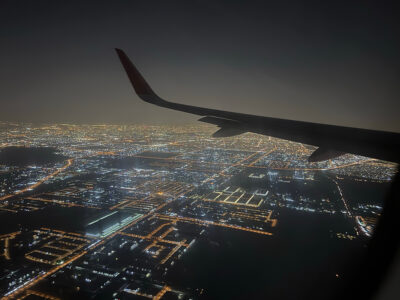Used for access and passport control, iris recognition systems are gradually being adopted in hubs across the world.
As innovative technologies take over all areas of life, it’s no surprise that airports are introducing iris recognition, an advanced security device used to identify passengers quickly in a fast-paced environment.
“Iris recognition involves taking a picture of the eye and it’s not damaging to the eye in any way. Every iris pattern is unique, which is what makes this technology work,” explains Justin Harrison, project engineer at Panasonic.
It takes two seconds for the scan to register an eye pattern, meaning the process could speed up the identification process.
“Essentially what the iris recognition does is to take a high resolution image of the eye and then it can work out where the eye pattern is.” Once the pattern is identified it can then be compared to a database of registered people to determine if there is a match.”
Even in the case of identical twins, no two iris patterns will be the same, making the process more secure than traditional identification methods. And according to Mark Stanborough, head of sales for iris scan manufacturer, Aditech, it makes life much simpler for passengers.
“There’s no reason to carry any other documents like passports and ID cards. Iris recognition can do a one to many search on the database, meaning you wouldn’t have to carry that stuff. If you use a card based system for example, every member in the country has to have a card, so by using nothing but iris scanners they no longer need to carry cards with them.” Despite this, Stanborough does not believe passports will die out completely.
“People are still going to want to have the actual documents there, but it saves time having to produce documents when coming back into your home country. It really just speeds up the process.” In addition, passengers will be required to provide the appropriate visa information to go through the initial enrolment process which registers them on the system.
While concerns have been raised that this technology may cause congestion, Stanborough explains this is not the case. “It takes two seconds for the scan device to register an eye pattern, meaning, if used properly, the process could speed up the identification process.” In addition the registration process is quick, taking approximately five to 10 minutes.
“In terms of registering it on the iris register it just takes two or three photos of the eye to get one good enough to use,” says Harrison. “Contact lenses are ok for the enrolment process but glasses are removed. However any future times you actually use it you can wear glasses and sunglasses and still get through.”
There are two ways to adopt or introduce this type of technology depending on an individual country’s data protection laws. “BAA, a company which Panasonic provides for, do actually have the central database system, where everyone’s iris pattern is actually stored,” says Harrison.
“When you go to the reader it will go back to the central database before making the decision about whether to let them through or not. If you’re not registered it won’t let you through.”
The other way to introduce this system is with biometric passports, which appeals in European countries where data protection laws would not allow a central database. “The iris pattern can actually be stored on the passport itself. Instead of having to use a central server, where there can be privacy issues, the iris recognition system can do a comparison between that and your passport to make sure it’s you,” explains Harrison.According to experts, the system is not only easy to use but also one of the most secure. “The technology does not allow for duplicate enrolments,” explains Stanborough.
“Unlike with ID cards and passports, identities can be forged. You can’t steal someone’s eye print because every one is different. And the chances of the system getting it wrong and letting the wrong person through are one in 1.44 trillion,” he adds.
The Biometric Product Testing Final report, produced in 2001 by the Centre for Mathematics and Scientific Computing in the UK proved the technique had very high biometric accuracy, with no false matches in over two million cross comparisons.
It was perceived to be a very expensive technology to use but prices are always coming down.
Harrison argues it is the uniqueness of the human eye which makes this identification process so successful. From the age of one, an individual’s iris print remains stable throughout life, meaning the physical characteristics do not change with age. “The iris pattern doesn’t change so unlike things like finger prints which can change over the course of time, the iris pattern remains the same,” he adds.
Aside from its speed and accuracy, the system is also unobtrusive. “The passenger doesn’t have to touch anything,” explains Harrison. “In the case of airports, when you’re having lots of people all going through at once, it means passengers don’t have to go anywhere near the actual equipment and there are no privacy issues.”
While the technology has been proved to be safe, secure and easy to operate, there are still some reservations amongst airport officials and passengers. “With any system you get there’s always going to be people who think there’s a negative side to it,” points out Stanborough.
“Perhaps some people won’t want to use it because they perceive it as a new technology, even though Aditech has been providing these solutions for over ten years now. Originally it was perceived to be a very expensive technology to use but prices are always coming down and it can prove very cost effective against a lot of other technologies out there.”
Iris-based biometric recognition is becoming increasingly popular at borders and security checkpoints across the Middle East, although experts have raised concerns regarding its use in airports.
Maj Dr Fawwaz Khalil Dawood, head of the committee in charge of the iris system at the Interior Minister’s office in Abu Dhabi, says the iris recognition system alone may not be enough for busy UAE hubs, as it requires passenger cooperation.
“The iris detection network, which was introduced in 2003, requires cooperation from the surveillance subjects and is therefore used to verify limited numbers of people,” he points out.
At Abu Dhabi International Airport, management are introducing a facial recognition system, which integrates the iris system and compares a digital image of facial features with those stored on a database.
“A total of 46 cameras and an enrolment centre have been installed at the Abu Dhabi International Airport in the first phase,” explains Fawwaz Khalil Dawood. “Soon 50 more enrolment centres and as many cameras will be deployed at all checkpoints across the country.”






